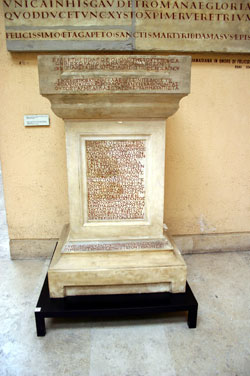
Feastday: October 22Bishop and apologist whose hagiography dates to the second century. The bishop of Hieropolis in Phrygia, he made a visit to Rome at the age of seventy-two. In Rome, Abercius was supposedly commanded by Emperor Marcus Aurelius to rid his daughter, Lucilla, of a demon. Following this event, Abercius is recorded as visiting Syria and the Euphrates River. The details of Abercius' life led to debate through the centuries concerning their authenticity and veracity. It is known that Abercius was the bishop of Heiropolis in the area called Phrygia Salutaris. In the original "Inscriptions of Abercius," an epitaph on a stele now in the Vatican, the saintly bishop comments on the dazzling seal of Baptism that unites Christians everywhere. He speaks of the Holy Eucharist as well. Later interpretations of this "Inscription" were written in Greek and widely embellished, leading to debate. Abercius appears in Greek records in the tenth century but was not included in St. Jerome's martyrology. 2nd-century Bishop of Hieropolis and saint
Death: 200
Abercius of Hieropolis (Greek Αβέρκιος, died c. 167) was a bishop of Hierapolis at the time of Marcus Aurelius, also known as Abercius Marcellus. He was supposedly the successor to Papias.
Abercius is said to have evangelized Syria and Mesopotamia, and is on that basis referred to as one of the Equals-to-the-Apostles. He was imprisoned under Marcus Aurelius, and died about 167.
Abercius' feast day is celebrated on 22 October (for those churches which follow the Julian Calendar, 22 October occurs on the Gregorian Calendar date of 4 November).
Several works are ascribed to Abercius:
- An Epistle to the Emperor Marcus Aurelius, of which Baronius speaks as extant, but he does not produce it
- A Book of Discipline (Greek Βίβλος διδασκαλίας) addressed to his clergy; this too is lost.
Abercius is also the subject, and probable author, of the Inscription of Abercius, preserved in the Vatican Museums.
William Ramsay said that "Abercius was bishop of Hieropolis in the valley of Sandukli and not of Hierapolis in the Maeander valley, for the latter was in Phrygia Magna, or Pacatiana." He said, "The confusion of the two towns Hierapolis and Hieropolis has produced much error in early Christian history. ... Hierapolis of Salutaris must always be interpreted as the Hieropolis in the valley of Sandukli: Hierapolis near Laodicea is always assigned in the Byzantine authorities to Pacatiana." J. B. Lightfoot said that "the city of Abercius was not Hierapolis on the Mæander but this Hieropolis near Synnada." The Catholic Encyclopedia notes that Ramsay "discovered at Kelendres, near Synnada, in Phrygia Salutaris (Asia Minor), a Christian stele (inscribed slab) bearing the date of the year 300 of the Phrygian era (a.d. 216). The inscription in question recalled the memory of a certain Alexander, son of Anthony. De Rossi and Duchesne at once recognized in it phrases similar to those in the epitaph of Abercius. On comparison it was found that the inscription in memory of Alexander corresponded, almost word for word, with the first and last verses of the epitaph of the Bishop of Hieropolis; all the middle part was missing. Mr. Ramsay, on a second visit to the site of Hieropolis, in 1883, discovered two new fragments covered with inscriptions, built into the masonry of the public baths. These fragments, which are now in the Vatican Christian Museum, filled out the middle part of the stele inscribed with the epitaph of Abercius. It now became possible, with the help of the text preserved in the Life, to restore the original text of the epitaph with practical certainty."





